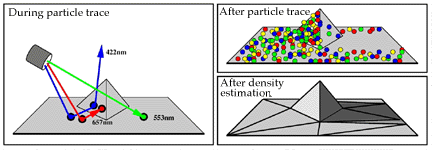|
|
Stage Two: Light Transport Simulation
Cornell University Program of Computer Graphics |
|
||||
|
Note: This page describes stage two of a research framework for global illumination which was first presented at a special SIGGRAPH session in August of 1997. The full text of the paper is available from the Program of Computer Graphics on-line publications.
The general equations to simulate the light transport for global illumination have been well known [KAJI86], but until recently neither the processing power nor the first stage of our framework, physically based reflection models, were available to perform accurate simulations. Most algorithms make simplifying assumptions, for the BRDF function, for the visibility computation, and for the solution of the integral equation over all incoming and outgoing directions. The two most common methods used are ray-tracing, introduced to the graphics community in 1979 [WHIT80], and radiosity, first presented five years later [GORA84]. Although during the past fifteen years many improvements have been made, neither of these commonly used algorithms are exact, each neglecting various and significant mechanisms of light transport.
Ray TracingIn essence, ray tracing reduces the BRDF expression to only include the path in specular direction [KAJI86], thus simplifying the computations but ignoring diffuse-diffuse and specular-diffuse interactions [WALL87]. Cook added a probabilistic framework to ray tracing to account for more phyiscal effects [COOK84], and Kajiya extended Cook's framework to include all transport paths for a probabilistic view-dependent solution [KAJI86], a method limited in practice by computation limits, but still an active area of work [LAFO96][VEAC95][WARD94].
RadiosityTraditionally, view-independent radiosity-type solutions have been computed by boundary element methods. These methods work by interleaving the computation of the global light transport and the local ligthing representation. In essesnce, these approaches model the transport processes by determining the "form-factor", the percentage of illumination leaving one surface element and reaching another. To create h igh quality images, the requirement of very find local representation, particularly in areas of high illumination gradients, e.g., shadow boundaries, gives rise to an exponential increase in elements. This combination of operations involving high global and high local complexity causes an explosion in resource consupmption in terms of both memory and time.Despite impressive advances in reducing computational tasks [HANR91][SMIT94][CAMP90][LISC93][TELL94], most schemes to date have been restricted to diffuse environments and static scenes. For more exact solutions, what is necessary is a physically based approach that can handle complex geometric environments with arbitrary reflectance functions, resulting in accurate solutions with known error characteritics.
Density Estimation FrameworkFor our predictive simulations, we have chosen a density estimation framework which avoids the combination of high local and global complexity by splitting light transport and lighting representation into separate computational stages [WALT97a]. In the transport stage we computer the flow of light between surfaces without ever explicitly reconstructing the lighting on surfaces. Particle tracing is a natural and robust way to simulate this light flow. The representation stage then uses information from the transport stage to explicitly reconstruct the lighting on each surface independently. Since the intensity of the lighting is proportional to the density of light particles, the reconstruction is a density estimation problem [SILV86]. A variety of different density estimation techniques have been applied, but our approach is the only one to date which separates the transport and reconstruction phases. Because each stage has only high global or high local complexity but not both, the individual stages require fewer resouces than finite element radiosity methods, especially in terms of memory. Although computational requirements are still enormous, a major benefit of this approach is that particle tracing can easily exploit coarse-grain parallelism, thus reducing computaton time.

The current implementation reconstructs irradiance function over the surfaces, which amounts to the reconstruction of radiance function for diffuse surfaces only. However, the density estimation framework could be extended to reconstruct the radiance function for non-diffuse surfaces as well. The major unresolved issue is to find an efficient mechanism for storing the directional information. Solutions to this problem are currently being investigated [WALT97b].
Light Transport Measurement and Image ValidationThese first two stages of our global illumination framework, we have sought to simulate the light reflection and light transport processes. Measurements and comparisons of the resulting radiometric scene values provide a critical feedback loop to verify the accuracy of our light reflection models and light transport algorithms.
Perceptual IssuesIf the results of the first two physical stages are accurate, we then can proceed to the third stage of our global illumination research framework, visual display. Since any comparison must utilize the human vision system, this stage occurs entirely in the perceptual domain.GoalsIn summary, our specific long-term goals for light transport are:
Lead Researchers and Collaborators
Publications
References
| ||||||
| ||||||